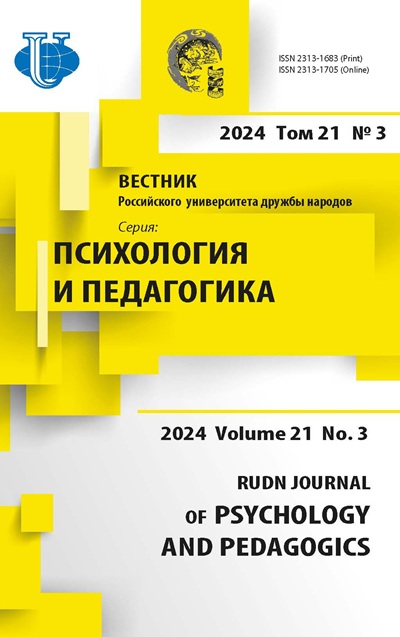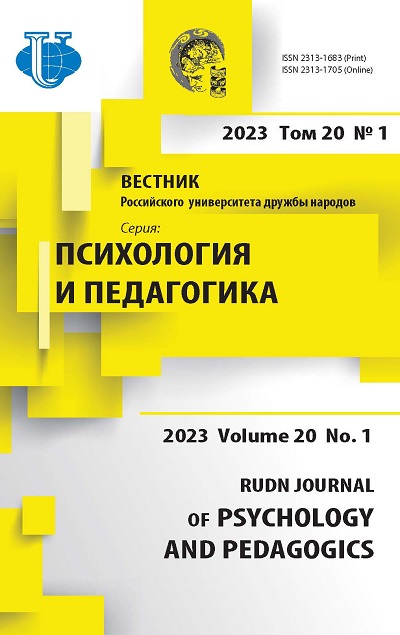Hardiness and Subjective Well-being of Siberian Schoolchildren Who Have Different Levels of Migration Attitudes: The Example of the Omsk Region
- Authors: Potapova Y.V.1, Malenova A.Y.1, Malenov A.A.1, Potapov A.K.1
-
Affiliations:
- Dostoevsky Omsk State University
- Issue: Vol 20, No 1 (2023)
- Pages: 67-86
- Section: PERSONALITY AND CONTEMPORARY CHALLENGES
- URL: https://journals.rudn.ru/psychology-pedagogics/article/view/34286
- DOI: https://doi.org/10.22363/2313-1683-2023-20-1-67-86
- EDN: https://elibrary.ru/DPXZCJ
Cite item
Full Text
Abstract
Due to the growing rates of migration of young people from the Siberian region to the west, it is becoming increasingly relevant to study the personal prerequisites for making a decision to change their place of residence. Schoolchildren as future graduates and applicants are one of the most mobile groups of population. Knowledge of the socio-psychological factors of their migration attitudes will enable the region to create optimal conditions for further education and work of young specialists, preventing their outflow. The purpose of this study is to analyze the level and structure of subjective well-being and hardiness of schoolchildren in the Omsk region who have different levels of migration attitudes. The authors describe the types of schoolchildren with different levels of migration attitudes from the standpoint of personal and demographic characteristics. They conducted a survey and testing using the following tools: the personal subjective well-being diagnostic technique (by R.M. Shamionov and T.V. Beskova); S. Muddy’s Hardiness Survey (adapted by D.A. Leontiev and E.I. Rasskazova); personal migration attitudes scale (by S.A. Kuznetsova); the author’s questionnaire. The study involved 461 students (females - 58.1%) of secondary schools in Omsk and the Omsk region (Mage =15.5; SD = 1.39). As a result, three types of schoolchildren with different level of migratory attitudes were identified. The desire for a settled life is demonstrated by the schoolchildren with relatively higher subjective well-being and hardiness, as well as a high level of challenge. The highest level of migration attitudes was found in the schoolchildren with a relatively lower level of subjective well-being and hardiness, as well as a low level of commitment. The schoolchildren with average migration attitudes are psychologically similar to those striving for migration, but they have a relatively lower existential-activity and social-normative well-being; in addition, their commitment is at an average level.
About the authors
Yuliya V. Potapova
Dostoevsky Omsk State University
Author for correspondence.
Email: kardova.jv@gmail.com
ORCID iD: 0000-0002-1226-8982
SPIN-code: 5026-5940
PhD in Psychology, is Associate Professor of General and Social Psychology Department
55 Prospekt Mira, Omsk, 644077, Russian FederationArina Yu. Malenova
Dostoevsky Omsk State University
Email: malyonova@mail.ru
ORCID iD: 0000-0001-5778-0739
SPIN-code: 8179-3954
PhD in Psychology, Associate Professor, is Associate Professor of General and Social Psychology Department
55 Prospekt Mira, Omsk, 644077, Russian FederationAleksandr A. Malenov
Dostoevsky Omsk State University
Email: malyonov@mail.ru
ORCID iD: 0000-0002-3654-956X
SPIN-code: 9545-2314
PhD in Psychology, is Head of the Educational and Scientific Laboratory
55 Prospekt Mira, Omsk, 644077, Russian FederationAlexander K. Potapov
Dostoevsky Omsk State University
Email: poalexk2187@yandex.ru
ORCID iD: 0000-0001-5890-9987
SPIN-code: 9006-6277
PhD in History, is lecturer at the Secondary Vocational Education Institute
55 Prospekt Mira, Omsk, 644077, Russian FederationReferences
- Arbuz, A.V. (2016). Migration intentions of the university graduates in Omsk. Herald of Omsk University. Series: Economics, (4), 139–146. (In Russ.)
- Arbuz, A.V. (2018). Professional self-determination and professional orientation of the youth of the Omsk region in the context of migration. Herald of Omsk University. Series: Economics, (3), 164–172. (In Russ.) https://doi.org/10.25513/1812-3988.2018.3.164-172
- Bakina, A.V., Orlova, O.A., & Yaremtchuk, S.V. (2018). Socio-psychological space of Komsomolsk-on-Amur among young people with different migration intentions. Russian Journal of Education and Psychology, 9(7), 36–62. (In Russ.) https://doi.org/10.12731/2218-7405-2018-7-36-62
- Bjarnason, T. (2014). Adolescent migration intentions and population change: A 20-year follow-up of Icelandic communities. Sociologia Ruralis, 54(4), 500–515. https://doi.org/10.1111/soru.12050
- Byuraeva, Yu.G., & Piskunov, E.Yu. (2020). The migrational intentions of student youth of the far eastern region (on the materials of the republic of Buryatia). Tomsk State University Journal, (459), 98–106. (In Russ.) https://doi.org/10.17223/15617793/459/12
- Chort, I. (2014). Mexican migrants to the US: What do unrealized migration intentions tell us about gender inequalities? World Development, 59, 535–552. https://doi.org/10.1016/j.worlddev.2014.01.036
- Dommermuth, L., & Klüsener, S. (2018). Formation and realisation of moving intentions across the adult life course. Population, Space and Place, 25(5), e2212. https://doi.org/10.1002/psp.2212
- Gabdrakhmanov, N.K. (2019). Concentration of students in higher education on the map of the Russian Federation. RUDN Journal of Economics, 27(1), 7–17. (In Russ.) https://doi.org/10.22363/2313-2329-2019-27-1-7-17
- Gajdošová, B., & Orosová, O. (2019). Selected psychological factors in relation to emigration intentions of voluntary permanent migration of university students. Ceskoslovenska Psychologie, 63(3), 249–264.
- Goltsova, E.V. (2015). Factors of social environment as determinants of migratory behavior of youth in the Irkutsk region. The Buryat State University Bulletin, (14–1), 51–55. (In Russ.)
- Hooijen, I., Meng, C., & Reinold, J. (2020). Be prepared for the unexpected: The gap between (im)mobility intentions and subsequent behaviour of recent higher education graduates. Population, Space and Place, 26(5), e2313. https://doi.org/10.1002/psp.2313
- Hoppe, A., & Fujishiro, K. (2015). Anticipated job benefits, career aspiration, and generalized self-efficacy as predictors for migration decision-making. International Journal of Intercultural Relations, 47, 13–27. https://doi.org/10.1016/j.ijintrel.2015.03.025
- Ivanova, E.I. (2017). Migration intentions of contemporary generations in Russia: A new wave. Studies on Russian Economic Development, 28(3), 317–326 https://doi.org/10.1134/S1075700717030066
- Ivlevs, A., & King, R.M. (2012). Family migration capital and migration intentions. Journal of Family and Economic Issues, 33(1), 118–129. https://doi.org/10.1007/s10834-011-9269-9
- Kley, S. (2017). Facilitators and constraints at each stage of the migration decision process. Population Studies, 71(sup1), 35–49. https://doi.org/10.1080/00324728.2017.1359328
- Konstantinova, A.G. (2014). Statistical analysis of the main parameters of the migratory movement of the population in the Irkutsk region. Humanities, Social-Economic and Social Sciences, (8), 69–72. (In Russ.)
- Kuznetsova, S.A. (2015). Migratory attitudes in Magadan inhabitants with different level of subjective control. RUDN Journal of Psychology and Pedagogics, (3), 75–83. (In Russ.)
- Kuznetsova, S.A. (2017). Correlation of migratory attitudes of Magadan inhabitants and features of their defensive-coping behaviour. RUDN Journal of Psychology and Pedagogics, 14(1), 64–75. (In Russ.) https://doi.org/10.22363/2313-1683-2017-14-1-64-75
- Kuznetsova, S.A. (2018). Time prospects and migratory attitudes of Magadan students at different stages of education. RUDN Journal of Psychology and Pedagogics, 15(1), 67–78. (In Russ.) https://doi.org/10.22363/2313-1683-2018-15-1-67-78
- Kuznetsova, S.A., Kuznetsov, I.U., & Feschenko, A.V. (2014). Working out migratory attitudes scale of personality. RUDN Journal of Psychology and Pedagogics, (1), 83–90. (In Russ.)
- Laczko, F., Tjaden, J., & Auer, D. (2017). Measuring global migration potential, 2010–2015. Global Migration Data Analysis Centre: Data Briefing Series, (9). Retrieved September 15, 2022, from https://publications.iom.int/books/global-migration-data-analysis-centre-data-briefing-series-issue-no-9-july-2017
- Leontev, D.A., & Rasskazova, E.I. (2006). Hardiness survey. Moscow: Smysl Publ. (In Russ.)
- Lychko, S.K., & Mosienko, N.L. (2014). City attractiveness as a factor of formation of students’ attitudes to migration. Vestnik Novosibirskogo Gosudarstvennogo Universiteta. Seriya: Sotsial'no-Ekonomicheskie Nauki, 14(1), 160–169. (In Russ.)
- Markov, V.I., Volkova, T.A., & Akhmetgaleeva, Z.M. (2021). Image of a region and internal migration motivation on the part of students of regional universities (a case of Kuzbass, Russia). Proceedings of Altai State Academy of Culture and Arts, (3), 20–28. (In Russ.) https://doi.org/10.32340/2414-9101-2021-3-20-28
- Marsiglia, F.F., Kulis, S., Hoffman, S., Calderón-Tena, C.O., Becerra, D., & Alvarez, D. (2011). Migration intentions and illicit substance use among youth in central Mexico. Substance Use & Misuse, 46(13), 1619–1627. https://doi.org/10.3109/10826084.2011.590957
- Murashcenkova, N.V. (2021). Psychological factors of youth emigration intentions: A review of international studies. RUDN Journal of Psychology and Pedagogics, 18(1), 25–41. (In Russ.) https://doi.org/10.22363/2313-1683-2021-18-1-25-41
- Murashcenkova, N.V., Gritsenko, V.V., Efremenkova, M.N., Kalinina, N.V., Kulesh, E.V., Konstantinov, V.V., Gurieva, S.D., & Malenova, A.Yu. (2022). Ethnic, civic, and global identities as predictors of emigration activity of student youth in Belarus, Kazakhstan, and Russia. Cultural-Historical Psychology, 18(3), 113–123. (In Russ.) https://doi.org/10.17759/chp.2022180314
- Nedoseka, E.V., & Sharova, E.N. (2020). Features of youth’s life strategies in the Arctic. Monitoring of Public Opinion: Economic and Social Changes, (3), 355–-375. (In Russ.) https://doi.org/10.14515/monitoring.2020.3.1611
- Novopashina, L.A. (2016). Monitoring of the population well-being as a tool for migration flows of labor resources management. Eurasian Union of Scientists, (31–2), 37–43. (In Russ.)
- Obukhova, V.I. (2020). Factors of migration activity of urban and rural youth. Skif. Voprosy Studencheskoi Nauki, (1), 309–313. (In Russ.)
- Odintsov, A.V., Shipitsin, A.I., & Marchenko, A.Yu. (2020). Centripetal migration of young people from the Russian province: Causes and trends (example of Volgograd Region). Monitoring of Public Opinion: Economic and Social Changes, (3), 335–354. (In Russ.) https://doi.org/10.14515/monitoring.2020.3.788
- Popova, O., & Otrachshenko, V. (2011). Life (dis)satisfaction and decision to migrate: Evidence from Central and Eastern Europe. SSRN Electronic Journal. https://doi.org/10.2139/ssrn.1982502
- Rocheva, А.L., & Varshaver E.A. (2020). Migration intentions of youth with and without migrant backgrounds: A Russian case. Monitoring of Public Opinion: Economic and Social Changes, (3), 295–334. (In Russ.) https://doi.org/10.14515/monitoring.2020.3.1632
- Shadrikov, A.V., & Ildarkhanova, Ch.I. (2018). Territorial interests of rural youth: experience of the Republic of Tatarstan, Altai Krai, and the Republic of Mordovia. Problems of Territory’s Development, (6), 107–118. (In Russ.) https://doi.org/10.15838/ptd.2018.6.98.7
- Shamionov, R.M., & Beskova, T.V. (2018). Methods of diagnostics of subjective well-being of the person. Psychological Studies, 11(60), 8. (In Russ.) https://doi.org/10.54359/ps.v11i60.277
- Skripnik, E.O. (2010). Migration intentions of the Khabarovsk region urban population. Spatial Economics, (4), 42–57. (In Russ.)
- Tabor, A.S., Milfont, T.L., & Ward, C. (2015). The migrant personality revisited: Individual differences and international mobility intentions. New Zealand Journal of Psychology, 44(2), 89–95.
- Thulin, E., & Vilhelmson, B. (2016). The Internet and desire to move: The role of virtual practices in the inspiration phase of migration. Tijdschrift Voor Economische En Sociale Geografie, 107(3), 257–269. https://doi.org/10.1111/tesg.12144
- Van Mol, C. (2016). Migration aspirations of European youth in times of crisis. Journal of Youth Studies, 19(10), 1303–1320. https://doi.org/10.1080/13676261.2016.1166192
- Vyalshina, A.A., & Dakirova, S.T. (2020). Sociological analysis of migration attitudes of rural school graduates. Regionology, 28(1), 159–183. (In Russ.) https://doi.org/10.15507/2413-1407.110.028.202001.159-183
- Zaikov, K.S., Katorin, I.V., & Tamitskii, A.M. (2018). Migration attitudes of the students enrolled in Arctic-focused higher education programs. Economic and Social Changes: Facts, Trends, Forecast, 11(3), 230–247. (In Russ.) https://doi.org/10.15838/esc.2018.3.57.15

















